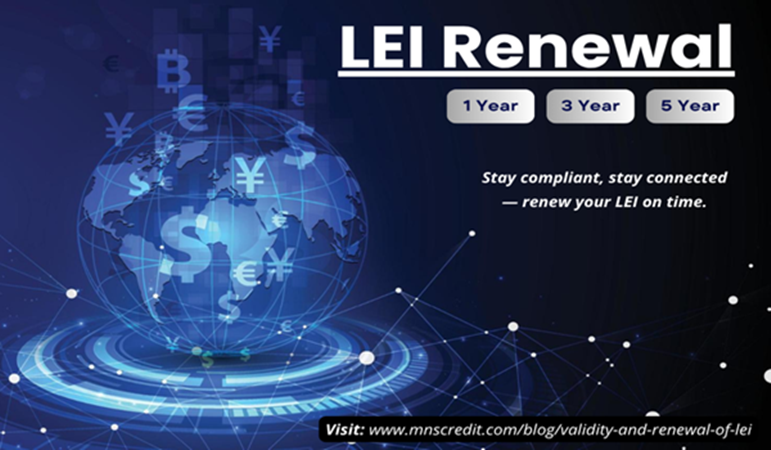In today’s interconnected financial world, transparency, accountability, and compliance are more critical than ever. Legal Entity Identifiers (LEIs) have become a cornerstone of global financial regulations, enabling clear and consistent identification of entities across markets and jurisdictions. However, obtaining an LEI is not a one-time task. LEI renewal is an annual requirement, and failing to renew can result in operational disruptions, regulatory non-compliance, and reputational risks.
This article delves into why LEI renewal is essential, the process involved, the consequences of non-renewal, and how maintaining updated information in global registries ensures your entity remains transparent and trustworthy.
What Is an LEI and Why Does It Matter?
The Legal Entity Identifier (LEI) is a 20-character alphanumeric code that uniquely identifies legally distinct entities engaging in financial transactions. Developed as part of the G20’s response to the 2008 financial crisis, the LEI system promotes transparency in the global financial ecosystem.
Each LEI code is tied to reference data, including:
- Legal name of the entity
- Country of incorporation
- Entity status (active/inactive)
- Relationship data (ownership/control)
This information is publicly available via the Global Legal Entity Identifier Foundation (GLEIF) database and plays a crucial role in risk management, compliance, KYC (Know Your Customer) procedures, and regulatory reporting.
What Is LEI Renewal?
LEI renewal refers to the mandatory process of updating and revalidating the information associated with a Legal Entity Identifier every year. Unlike static identifiers such as tax ID numbers, LEIs require annual revalidation to ensure the underlying reference data is accurate and up to date.
Even if your company’s details haven’t changed, you must still go through the renewal process to confirm and validate the current information.
Why Is LEI Renewal So Important?
There are several critical reasons why timely LEI renewal is essential:
1. Regulatory Compliance
Financial regulators across the globe—including the European Securities and Markets Authority (ESMA), the U.S. Commodity Futures Trading Commission (CFTC), and others—require active LEIs for reporting. An expired LEI can lead to non-compliance with reporting obligations, especially under regulations like MiFID II, EMIR, Dodd-Frank, and SFTR.
2. Operational Continuity
Financial institutions and trading platforms often reject transactions involving entities with expired LEIs. This can delay trades, freeze access to financial markets, or even block access to funding.
3. Data Integrity
The value of the LEI system lies in the accuracy and consistency of entity data. LEI renewal ensures that names, legal status, addresses, and ownership structures reflect the entity’s current standing, improving trust across the financial ecosystem.
4. Reputation Management
Failing to renew your LEI may raise red flags among counterparties and regulators. An inactive or expired LEI can signal negligence or lack of transparency, damaging for entities in regulated or investor-facing industries.
How to Renew an LEI Code
Renewing an LEI is a straightforward but critical task. Here’s a step-by-step breakdown of the process:
Step 1: Choose an LEI Issuer (LOU or Registration Agent)
LEIs are issued and renewed through Local Operating Units (LOUs) or Registration Agents accredited by GLEIF. You are not restricted to the LOU you initially registered with—you can switch if another provider offers better service or pricing.
Step 2: Submit Your Renewal Application
You’ll need to provide or confirm the following information:
- Legal name and address
- Company registration number
- Parent company or ultimate controlling party (if applicable)
- Authorized signatory details
If your entity’s information hasn’t changed, the process involves confirming and validating existing data.
Step 3: Verification and Payment
The LEI issuer verifies your entity’s data against public business registries and other sources. Once approved and payment is made (usually $50–$100 USD per year), the renewed LEI is updated in the GLEIF database.
Step 4: Confirmation and Certificate
After successful renewal, you’ll receive confirmation and can download your updated LEI certificate. Your entity status in the GLEIF database will change from “Lapsed” to “Issued” or “Active”.
When Should You Renew Your LEI?
LEI codes are valid for one year from the date of initial registration or the last renewal. It’s best to renew at least 2–4 weeks before the expiration date to avoid a lapse in status. Many providers offer auto-renewal services or multi-year packages to help streamline the process and avoid missing deadlines.
Consequences of Not Renewing Your LEI
Allowing your LEI to lapse can have serious consequences:
- Regulatory reporting failures
- Trade rejections or delays
- Increased compliance scrutiny
- Potential fines or penalties
- Damage to trust and transparency
In some jurisdictions, regulatory authorities may issue warnings or sanctions for operating with a lapsed LEI.
Updating Entity Data in Global Registries
Beyond renewal, it’s equally important to keep your LEI reference data accurate and up to date. Any change in legal structure, name, ownership, or address should be reported promptly through the LEI issuer, so that the global registry reflects the current status of the entity.
Why This Matters:
- Regulators rely on accurate LEI data for surveillance and systemic risk management.
- Banks and trading partners use LEI data to assess counterparty risk.
- Accurate LEI data reduces operational errors and improves onboarding efficiency.
Best Practices for LEI Renewal and Data Management
- Set Calendar Reminders
Mark the expiration date in your compliance calendar to avoid last-minute renewals. - Assign Responsibility
Designate a team or individual in legal or compliance to manage LEI renewals. - Review Ownership Changes Promptly
Any changes to parent or ultimate controlling parties must be reflected immediately. - Opt for Auto-Renewal
Many LEI issuers offer multi-year auto-renewal packages—consider these to ensure compliance. - Audit Your LEI Data Annually
Even if your LEI is active, review your public data in the GLEIF database to ensure accuracy.
Conclusion
LEI renewal is not just a regulatory requirement—it is a critical part of maintaining trust, transparency, and operational efficiency in global markets. Ensuring your LEI is active and your entity data is accurate allows your business to avoid compliance risks, operate smoothly, and contribute to a more transparent financial ecosystem.
In a landscape where data integrity and compliance are non-negotiable, timely LEI renewal is not an option—it’s a responsibility.


